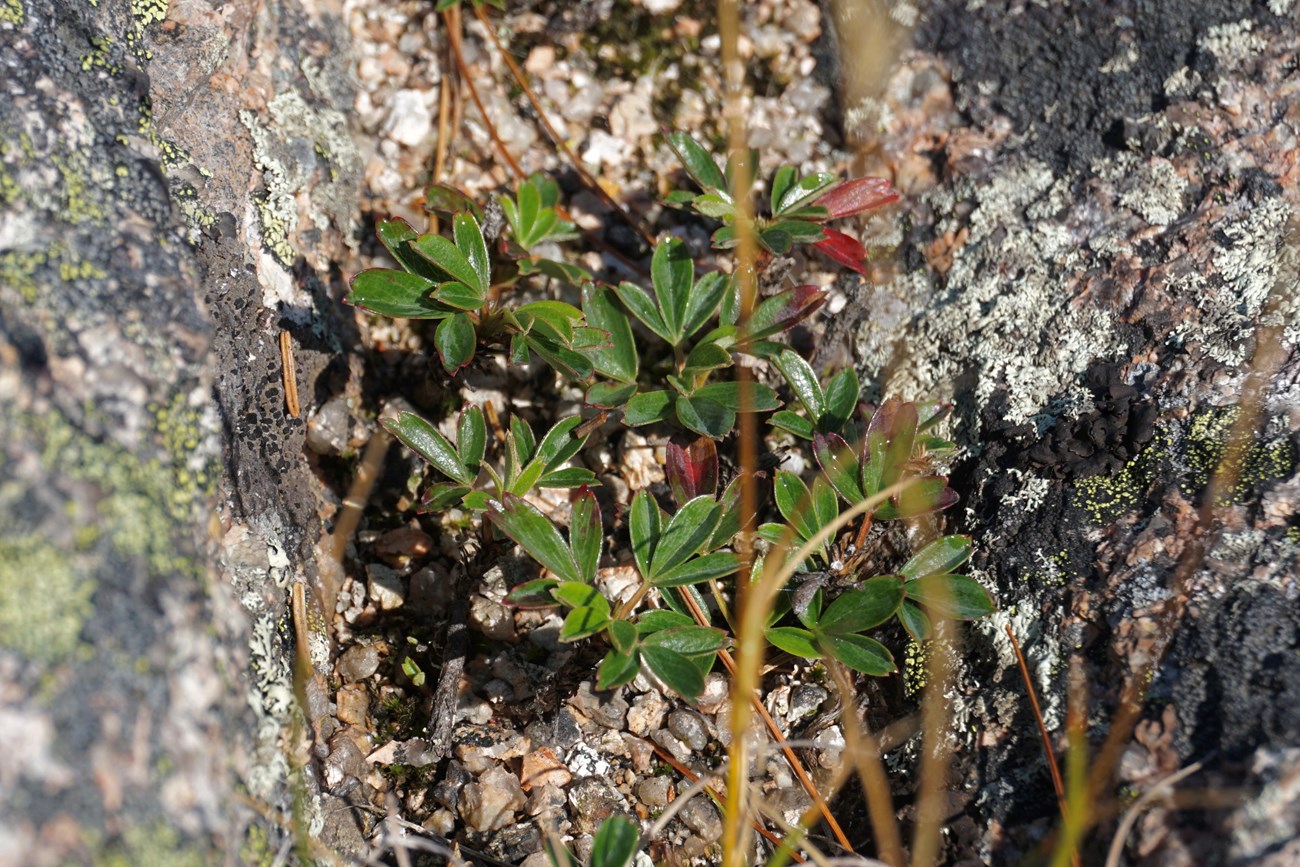Last updated: March 10, 2025
Article
To Seed or Not to Seed: A 2024 Update on Summit Restoration in Acadia

NPS photo by Nina Foster
Gravel crunched beneath the feet of hikers walking along the carriage road toward Waterfall Bridge. A waist-high pile of soil awaited their arrival. Their backpacks were about to get heavier, and the trek harder, upon carrying part of the pile to the summit of Sargent Mountain.
Heavy foot traffic and off-trail wandering have eroded soil and trampled low-growing plant communities on the summits of Acadia’s mountains. The soil loss is exacerbated by climate change, which subjects exposed peaks to more frequent and intense storms. For almost a decade, Acadia has worked with Friends of Acadia, Native Plant Trust, and Schoodic Institute to evaluate restoration methods on these degraded mountaintops.
The first phase of experiments on Cadillac Mountain revealed that soil is key to restoring summit vegetation. Spreading about an inch of soil on the test plots was enough for plants to take root. Driving soil to the top of Cadillac was easy — but expanding restoration efforts to less accessible peaks presented a challenge.

NPS photo by Nina Foster
The solution: the Save Our Summits Volunteer Program, an opportunity for hikers to bring locally sourced soil to the tops of Penobscot and Sargent Mountains. Volunteers can choose to carry between five pounds (the weight of a two-liter soda bottle) and 20 (the weight of an average watermelon).
Last year, volunteers helped carry 3,765 pounds of soil to the summits. Their contributions supported the restoration of 29 eroded areas. In 2024, Save Our Summits hikes took place every Wednesday through early September.

Photo courtesy of Evie Linantud, Friends of Acadia
“What’s key about doing this now is that we can hopefully hold the line and prevent further loss,” Acadia vegetation biologist Jesse Wheeler told the volunteers on the first Save Our Summits hike of the season. “You are a part of active restoration.”
The research and restoration efforts on Acadia’s summits are constantly evolving to address new scientific inquiries. “The main question that we’re trying to answer with this phase of restoration is, ‘Should we be seeding?’” explained Chris Nadeau, a climate change adaptation specialist with Schoodic Institute.
On Cadillac Mountain, some of the first test plots received seeds collected from local wild plants, while others were simply covered with soil. According to Wheeler, there was no statistical difference between the increase in plant cover of plots that were seeded and those that weren’t. The finding suggests that active seeding may not be a necessary step in restoring degraded summits. Instead, seeds from plants growing nearby may be enough to replenish vegetation, as long as there is soil to grow in.
However, some restoration experts from the National Park Service have suggested that seeding fast-growing species might be important to help hold the soil on the mountains. To further investigate this suggestion, half of the plots on Sargent and Penobscot are seeded with a mixture of fast-growing plant species, and half don’t get any seed. Nadeau said it’s too early to tell how the different methods will affect plant cover, but Schoodic Institute researchers will continue to monitor the plots for years to come.

NPS photo by Nina Foster
Another focus of summit restoration research is three-toothed cinquefoil (Sibbaldiopsis tridentata), a native plant with woody lower stems, compound evergreen leaves with three teeth at the edge of each leaflet, and small white flowers. The plant is thriving under current conditions and excels at holding soil on mountains, making it an important species for restoring eroded summits. But according to Nadeau, 98 percent of the locations in Maine that are suitable for three-toothed cinquefoil today are predicted to become too hot by the end of the century.
“Climate change is ever-present now. When we think about restoration, we need to be thinking about restoration for the future,” he said.
Nadeau’s team is exploring options for adapting three-toothed cinquefoil to climate change, such as collecting individuals of the same species from warmer locations and bringing them to Acadia. This practice could make the park’s three-toothed cinquefoil populations more resilient to warming temperatures, but it hasn’t been tested.
Researchers at Acadia are providing one of the first rigorous tests by planting three-toothed cinquefoil from warmer areas in gardens and monitoring their impact. Each garden contains three treatments: local three-toothed cinquefoil; three-toothed cinquefoil from locations approximately 2°C (3.6°F) warmer like Mount Megunticook in Camden, Maine; and a combination of both. Technicians remove flowers from the climate-adapted plants to keep them from spreading beyond research sites.

Photo courtesy of Evie Linantud, Friends of Acadia
As they reached the summit of Sargent Mountain, the hikers removed the extra weight from their packs and piled the bags of soil on an exposed rock. Nearby, three-toothed cinquefoil joined wild blueberries, goldenrods, and other mountain plants around an existing restoration plot. The soil was covered with biodegradable burlap, which protects the plot from erosion while plants develop a root system to hold the soil in place long term. Seedlings were just starting to poke through the fabric, a promising sign of vegetation’s return to the degraded site and the persistence of the park’s summit ecosystems.
